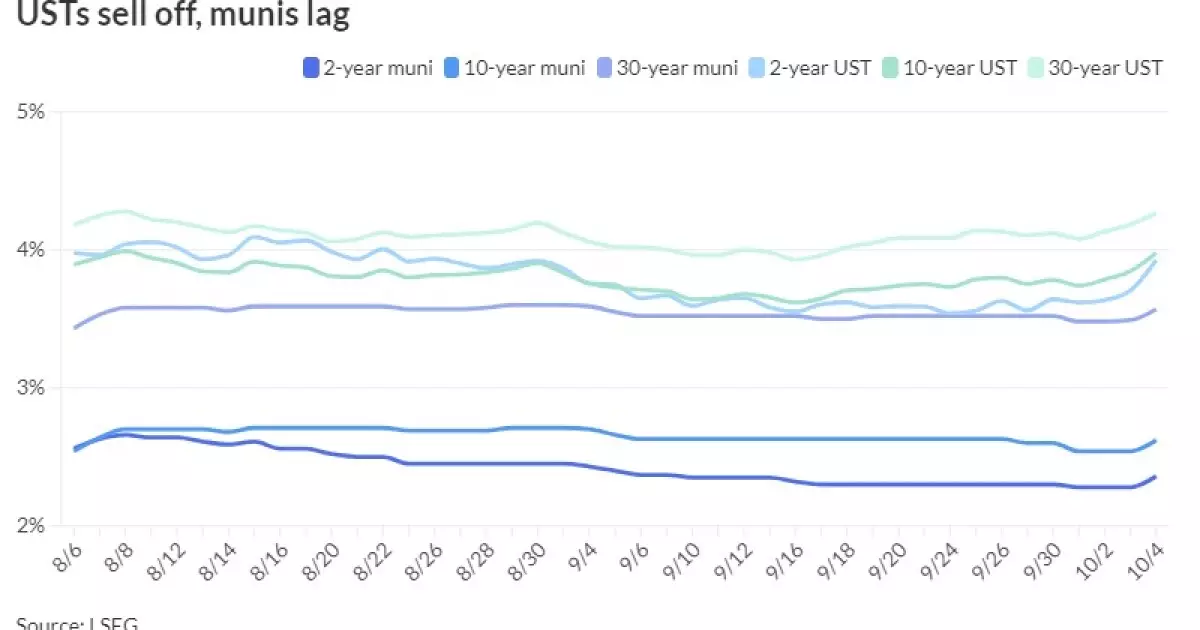The Shifting Landscape of U.S. Treasuries and Municipal Bonds Amid Strong Payroll Data

The financial landscape is continuously evolving, shaped by economic indicators, market sentiment, and policy decisions. Recent reports from the U.S. labor market have had immediate and pronounced effects on the bond market, especially U.S. Treasuries and municipal bonds. The unexpected surge in payroll figures has altered outlooks significantly, prompting traders and economists to revise their expectations regarding future interest rate cuts.
On a notable Friday, data disclosed by the Bureau of Labor Statistics revealed shockingly robust payroll growth, significantly surpassing pre-report estimates. This spike in employment not only caught market participants off-guard but also raised questions about the necessity and pace of future Federal Reserve rate cuts. As economists and analysts digested this news, many began to adjust their forecasts, leaning towards a more conservative view on the rate cut trajectory, particularly downplaying previous expectations for a drastic 50 basis points cut.
Lara Castleton, a prominent figure in the realms of portfolio construction and strategy at Janus Henderson Investors, commented on the implications of this report. According to her analysis, the data paints a clearer picture regarding the Fed’s recent policy adjustments aimed at normalizing interest rates suitable for the current economy. This view, if widely accepted, could lead to a more measured approach in investment strategies, as stability appears more plausible.
The repercussions of the strong job numbers were felt across the municipal bond market as well. Triple-A rated municipal bond yields rose in response, yet the demand for tax-exempt securities remained relatively resilient. This resilience is evident as municipal bonds outperformed their taxable counterparts, leading to lower ratios and tightening spreads.
Barclays PLC echoed these sentiments, affirming that the expectation now largely tilts toward a 25 basis point cut by the Federal Reserve rather than the more aggressive cut that had been floated before. Importantly, the yield curve’s flattening—created by the market’s quick repricing—poses unique challenges moving forward, especially for protections around tax-exempt municipal bonds as they navigate an increasingly complex environment.
As the fallout from the payroll report continues to reverberate, the municipal market anticipates an influx of new issues as market participants position themselves for attractive offerings. With approximately $10 billion in new issues scheduled for the first full week of October, investors will be navigating a busy pipeline that includes notable increases in taxable bond offerings.
Among the most significant offerings is New York City’s $1.5 billion taxable general obligation bond sale, designed to aid in financing various public initiatives. Notably, Connecticut is also bringing $935 million of general obligation bonds to market, further establishing a busy issuance calendar. These new offerings will undoubtedly attract attention amid shifting yield dynamics, and their success could influence long-term investor sentiments toward municipal bonds.
Investor psychology is critical during periods of shifting economic narratives. With the recent uptick in bond yields and the looming prospect of a substantial issuance schedule, a recalibration of expectations appears imminent. Market experts, including Mikhail Foux from Barclays, raised concerns about the upcoming supply’s impact on tax-exempt securities, underscoring the potential for increased rate volatility.
In light of the current dynamics, investors may find themselves reassessing strategies in the coming weeks. The juxtaposition of a positive jobs report and a heavier issuance calendar prompts a more cautious stance, as historical precedents suggest that increased supply can lead to downward pressure on prices, particularly if investor appetite wanes.
The interplay between labor market performance and monetary policy will remain a central theme in U.S. financial markets. With robust payroll growth altering the landscape and prompting a reassessment of future Federal Reserve actions, investors in both Treasury and municipal bonds must attentively monitor economic indicators, upcoming debt issuance, and market sentiment shifts. As the fourth quarter approaches, a prudent and strategic approach will be essential for navigating this reactive and evolving market terrain. With evolving expectations and potential volatility on the horizon, staying informed will be vital to capitalizing on opportunities while managing risks.





